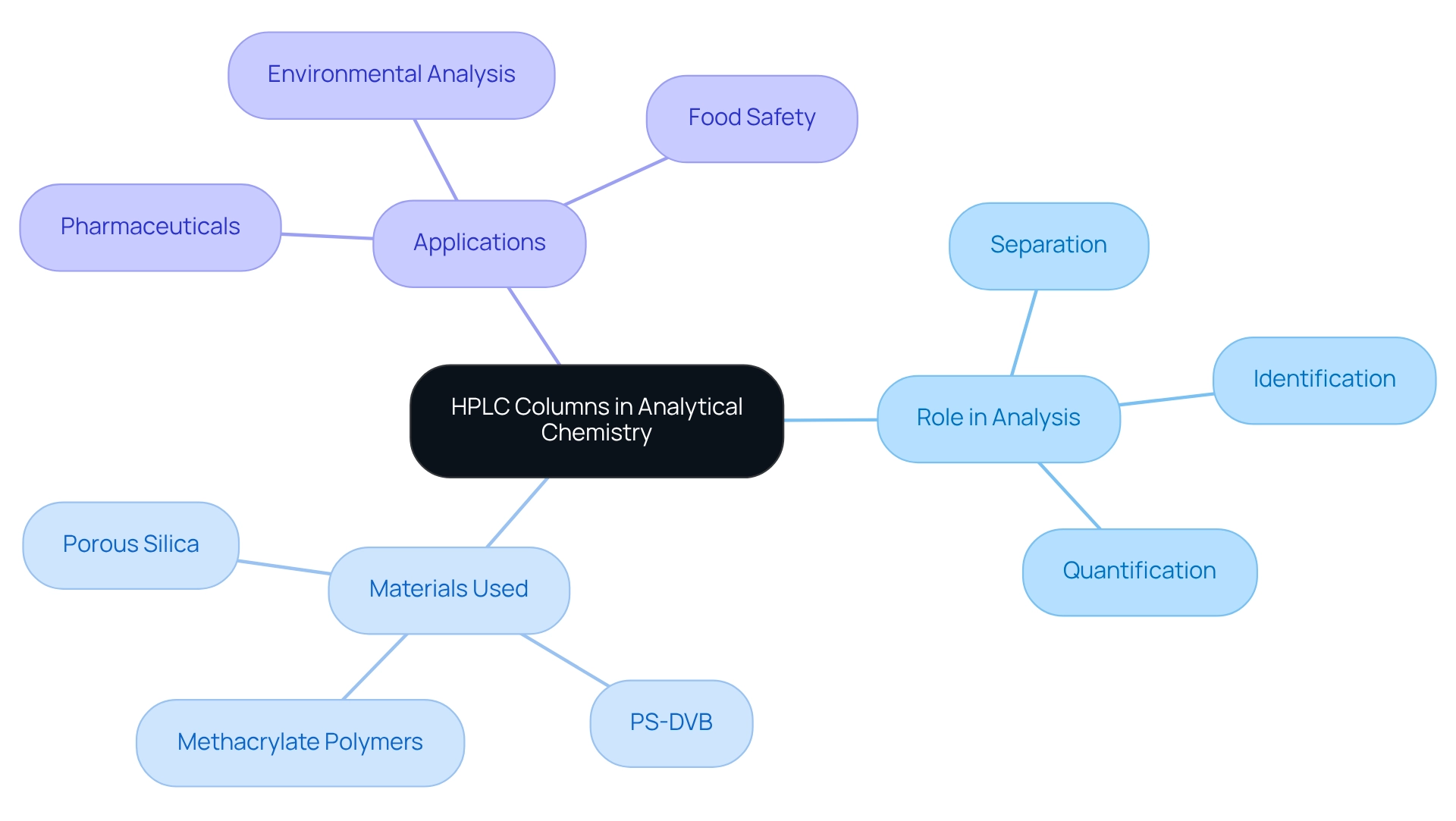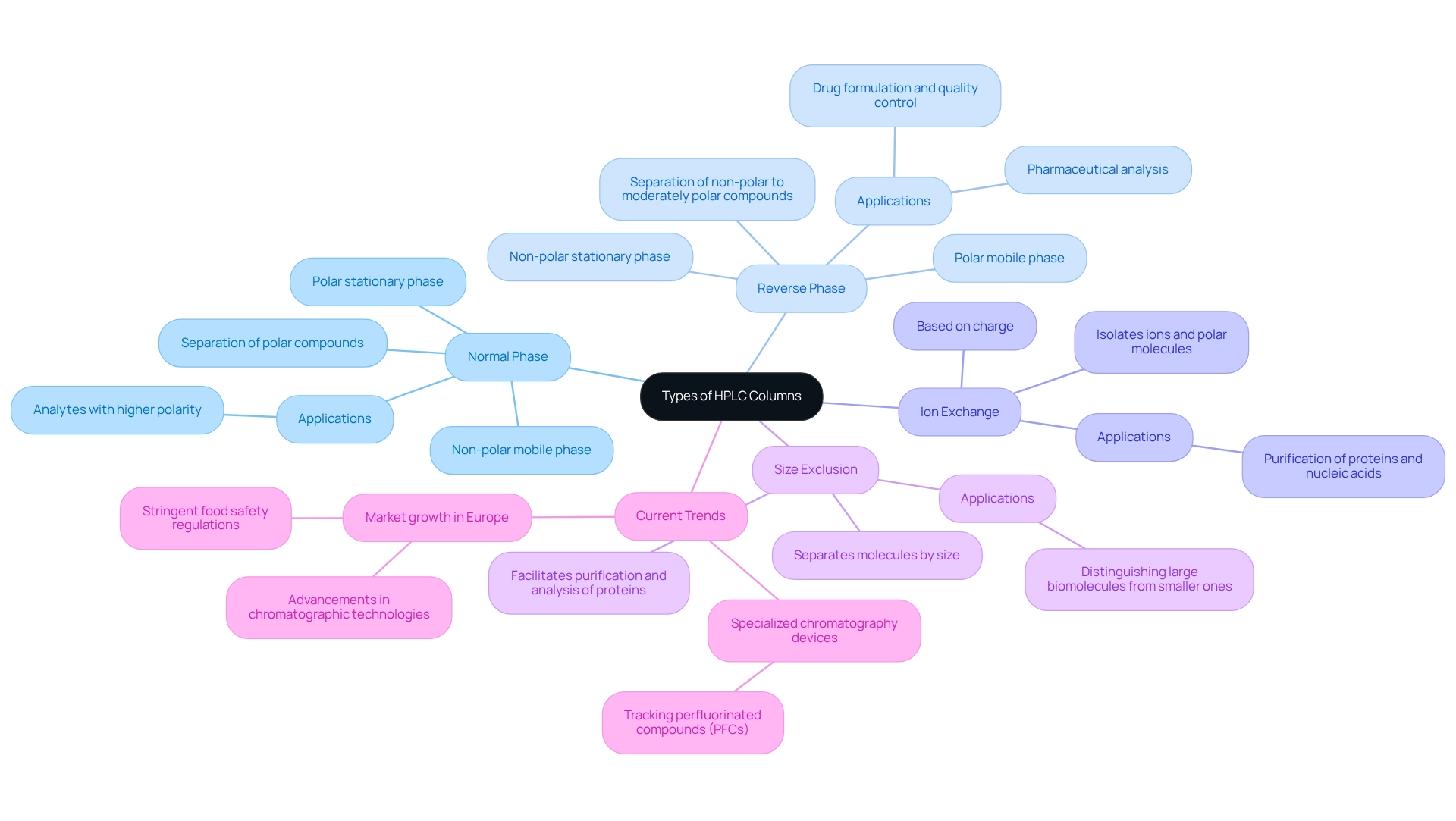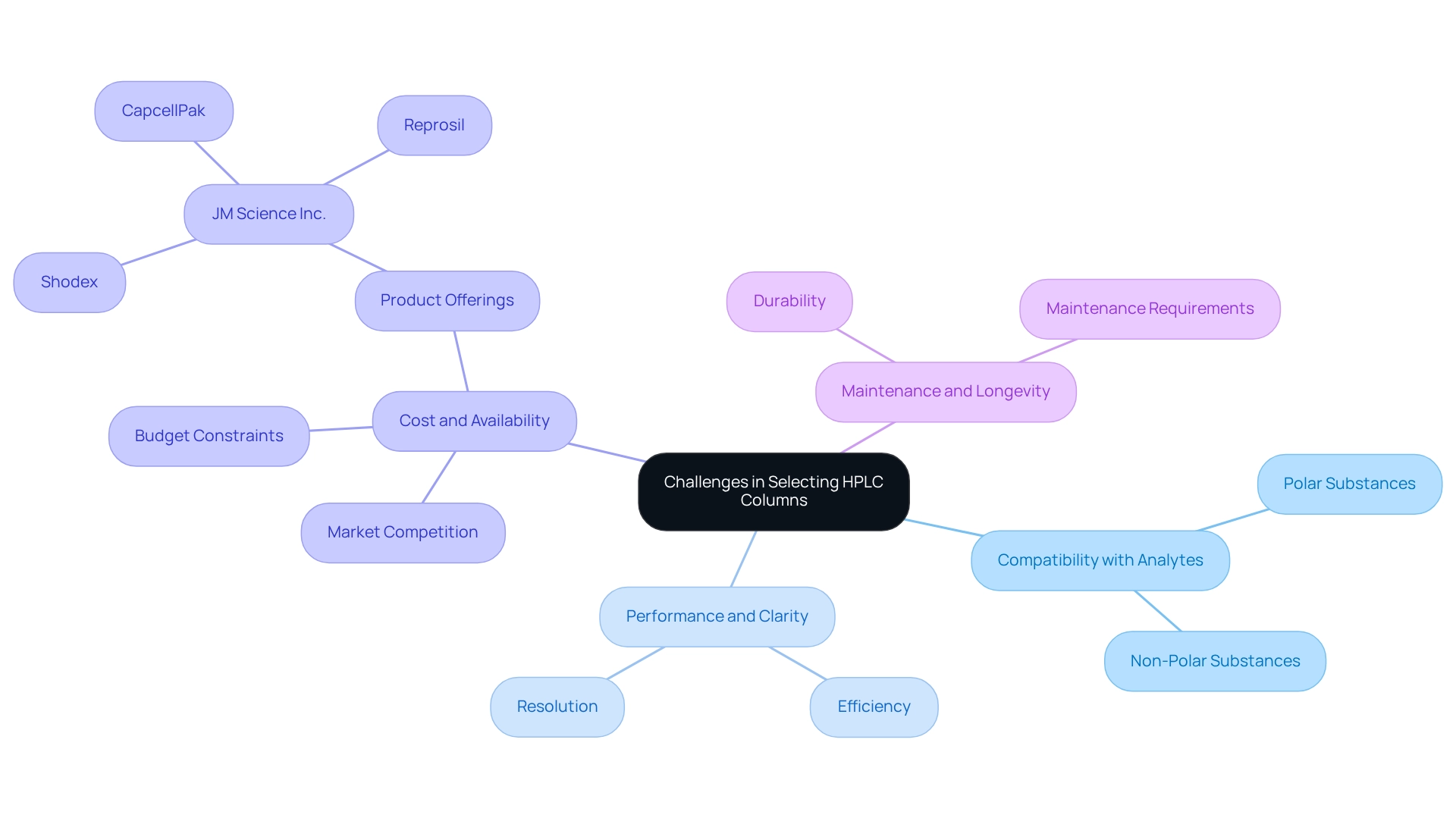Overview
This article delves into the diverse types of High-Performance Liquid Chromatography (HPLC) columns, elucidating their specific roles and applications within analytical chemistry. It categorizes column types, including:
- Normal phase
- Reverse phase
- Ion exchange
- Size exclusion
It underscores their critical importance in sectors such as pharmaceuticals, biotechnology, and environmental analysis. Supported by relevant case studies and current market trends, the discussion highlights the effectiveness and increasing demand for these columns. The insights presented not only inform but also prompt consideration of the essential role high-quality scientific instruments play in laboratory settings.
Introduction
In the realm of analytical chemistry, High-Performance Liquid Chromatography (HPLC) columns are indispensable tools, meticulously designed to separate, identify, and quantify compounds within intricate mixtures. As the backbone of HPLC techniques, these columns facilitate precise analysis, which is crucial for industries ranging from pharmaceuticals to environmental safety.
With the growing demand for innovative analytical solutions, understanding the evolution of HPLC column technology is vital. This exploration delves into the critical role that HPLC columns play in ensuring accurate results. Furthermore, it addresses the emerging trends and advancements that are shaping their future in scientific research and application.
Define HPLC Columns and Their Role in Analytical Chemistry
High-Performance Liquid Chromatography (HPLC) tubes are fundamental components in the liquid chromatography method, meticulously engineered to separate, identify, and quantify substances within complex mixtures. These tubes utilize a stationary medium, typically composed of porous silica particles, which engage with analytes as they traverse the apparatus. The significance of high-performance liquid chromatography devices in analytical chemistry is profound; they facilitate the effective separation of mixtures based on the varying affinities of substances for the stationary phase. This capability is particularly vital in the pharmaceutical sector, where precise analysis is critical for drug development and quality assurance.
In 2025, the role of chromatographic elements in pharmaceutical analysis is underscored by their contribution to the accuracy and reliability of results. As the demand for specialized analytical techniques escalates, the need for innovative chromatographic materials becomes increasingly evident. For instance, contemporary materials such as cross-linked polystyrene-divinylbenzene (PS-DVB) and methacrylate polymers are being utilized to achieve high-resolution separations of large biomolecules, including proteins and oligonucleotides, while maintaining stability under extreme conditions.
Case studies illustrate the evolving landscape of chromatography applications. The growing necessity for specialized liquid chromatography devices for the analysis of perfluorinated substances highlights the demand for heightened sensitivity and selectivity in monitoring persistent pollutants, thereby promoting environmental safety and regulatory compliance. Furthermore, expert insights emphasize that continuous advancements in chromatography technology are crucial to tackle the challenges posed by .
Overall, these analytical instruments play an indispensable role in laboratories, facilitating the separation of substances essential for a myriad of applications, including pharmaceuticals, environmental analysis, and food safety. Their capacity to provide precise and dependable results renders them vital tools within the analytical chemistry domain.

Explore Types of HPLC Columns: Normal Phase, Reverse Phase, Ion Exchange, and Size Exclusion
In analytical chemistry, HPLC columns are indispensable instruments, and there are various types of HPLC columns, each meticulously designed for specific applications.
- Normal Phase Columns utilize a polar stationary phase alongside a non-polar mobile phase, excelling in the separation of polar compounds. This configuration is particularly effective when analytes exhibit a higher polarity than the mobile medium, making them invaluable in a multitude of analytical applications.
- Reverse Phase Supports, the most prevalent type, feature a non-polar stationary phase paired with a polar mobile phase. This arrangement is optimal for separating non-polar to moderately polar compounds, which explains their extensive use in pharmaceutical analysis. Success stories in this domain underscore their effectiveness in drug formulation and quality control processes.
- Ion Exchange Devices operate by isolating ions and polar molecules based on their charge, rendering them crucial in biochemistry for the purification of proteins and nucleic acids. The growing demand for these devices is driven by advancements in biotechnology, underscoring the vital role of chromatography in biomolecule analysis. As Ronald E. Majors, business development manager at the Consumables and Accessories Business Unit, remarked, "The advent of the science of biotechnology in the U.S. was bringing more attention to the chromatography of biomolecules."
- Size Exclusion Columns, also known as gel filtration devices, separate molecules according to size, facilitating the purification and analysis of proteins. They are particularly adept at distinguishing large biomolecules from smaller ones, supporting essential applications in protein characterization.
Current trends indicate a rising interest in , such as those engineered for tracking perfluorinated compounds (PFCs), driven by environmental and health concerns. These innovative materials are crafted for high sensitivity and selectivity, reflecting the evolving landscape of chromatography technology. A case study titled 'Emerging Materials in Liquid Chromatography Columns' highlights the increasing necessity for specialized LC supports in response to these challenges, demonstrating their significance in safeguarding environmental and public health. Furthermore, the market is witnessing substantial growth in Europe, propelled by advancements in chromatographic technologies and stringent food safety regulations.
When comparing the various types of HPLC columns, it is critical to recognize that the surface area of packing particles is inversely proportional to the pore diameter of the device, which influences separation efficiency. As the field progresses, understanding the distinctions among the different types of HPLC columns, including normal phase, reverse phase, ion exchange, and size exclusion setups will be essential for optimizing analytical techniques and ensuring accurate results. Notably, an extensive report on high-performance liquid chromatography encompasses 257 pages and 325 tables and figures, underscoring the depth of research available in this field.

Examine Applications of HPLC Columns in Pharmaceuticals, Biotechnology, and Environmental Analysis
Chromatography devices play an essential role in numerous scientific fields, particularly in the following areas:
- Pharmaceuticals: In the realms of drug development and quality assurance, equipment from JM Science Inc. is indispensable for evaluating the purity of active pharmaceutical ingredients (APIs), identifying contaminants, and ensuring compliance with rigorous regulatory standards. Reverse phase materials, such as Shodex and CapcellPak, are commonly utilized in various types of HPLC columns to effectively separate and measure drug compounds within formulations, thereby preserving product integrity. Additionally, biotechnology applications for the purification of biomolecules, including proteins and peptides, heavily rely on these types of HPLC columns. JM Science's ion exchange and size exclusion materials, including Reprosil variants, excel in this domain, facilitating the separation of complex biological mixtures. As the demand for high-quality biomolecules continues to rise, the role of high-performance liquid chromatography, particularly the various types of HPLC columns, in biotechnology is expanding, underscoring its significance in research and development.
- Additionally, liquid chromatography systems are employed in environmental analysis to monitor pollutants across various matrices, including water, soil, and air. These systems enable the detection and quantification of contaminants such as pesticides and heavy metals, ensuring adherence to environmental regulations and contributing to public health safety. With an increasing emphasis on environmental preservation, further advancements in high-performance liquid chromatography technology, particularly the development of different types of HPLC columns, are anticipated, enhancing its application in this critical field.
- The market for these analytical devices is projected to experience significant growth, with the UK sector alone expected to reach USD 279.13 million by 2025, reflecting a compound annual growth rate (CAGR) of 5.5%. This growth is fueled by escalating investments in state-of-the-art laboratory tools, particularly within educational institutions, which are vital for advancing chromatography technologies. As the market evolves, innovations in liquid chromatography equipment and other offerings from JM Science, such as titrators and Karl Fischer reagents, will create new opportunities for both manufacturers and consumers, particularly in the pharmaceutical industry, where the demand for is paramount.

Challenges and Considerations in Selecting HPLC Columns
Selecting the appropriate types of HPLC columns involves several challenges and considerations that are critical for achieving optimal analytical results.
- Compatibility with Analytes: The chosen column must align with the chemical properties of the analytes. For instance, polar substances necessitate the use of normal phase materials, while non-polar substances are best analyzed with types of HPLC columns designed for reverse phase setups. This compatibility is essential for effective separation and accurate results.
- Performance and Clarity: Different types of HPLC columns exhibit varying degrees of efficiency and resolution, which directly influences the quality of separation. It is crucial to select a structure that meets the specific separation needs of the application, ensuring that the desired resolution is achieved without compromising analysis time.
- Cost and Availability: Budget constraints and the accessibility of different types of HPLC columns significantly impact the selection process. Researchers must navigate the competitive landscape of the chromatography market, where numerous established participants offer similar products. JM Science Inc. provides an extensive selection of high-quality chromatographic phases, including Shodex, CapcellPak, and Reprosil, ensuring that researchers can find the appropriate solution for their needs. Balancing performance with cost-effectiveness is vital, particularly in laboratory settings where financial resources may be limited.
- Maintenance and Longevity: The durability and maintenance requirements of high-performance liquid chromatography units can greatly affect operational efficiency. Opting for sections that are easy to maintain and possess a long lifespan can minimize downtime and reduce overall laboratory expenses. This consideration becomes increasingly important given the challenges laboratories face in acquiring reliable and efficient instrumentation for their analyses.
In 2025, the landscape of continues to evolve, driven by ongoing advancements and innovations. Laboratories must remain informed about the latest developments, including government regulations and patent laws that may influence product availability and selection. By understanding these factors and leveraging expert advice, researchers can make informed decisions that enhance their analytical capabilities. For example, JM Science Inc. addresses critical challenges faced by laboratories in obtaining reliable and efficient instrumentation for analyses, as highlighted in the case study titled "Challenges in Laboratory Instrumentation.

Conclusion
The exploration of High-Performance Liquid Chromatography (HPLC) columns reveals their indispensable role in analytical chemistry across various industries. These columns are meticulously designed to separate, identify, and quantify compounds, establishing them as essential tools in pharmaceuticals, biotechnology, and environmental analysis. Understanding the different types of HPLC columns—normal phase, reverse phase, ion exchange, and size exclusion—along with their specific applications, underscores their versatility and critical importance in achieving accurate analytical results.
As the demand for innovative analytical solutions continues to grow, so too does the need for advancements in HPLC column technology. Emerging materials and specialized columns are being developed to tackle the complexities of modern analytical challenges, such as monitoring environmental pollutants and ensuring the purity of pharmaceutical products. This ongoing evolution not only enhances the performance of HPLC systems but also supports compliance with stringent regulatory standards.
Selecting the right HPLC column necessitates careful consideration of various factors, including compatibility with analytes, efficiency, cost, and maintenance needs. By staying informed about the latest advancements and understanding the unique properties of each column type, researchers can optimize their analytical methods and achieve reliable results. As the field of analytical chemistry progresses, HPLC columns will undoubtedly remain at the forefront, driving innovation and ensuring the accuracy and integrity of scientific analysis.




